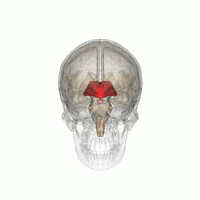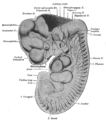Diencephalon: Difference between revisions
Neuron Doc (talk | contribs) |
DerekWinters (talk | contribs) No edit summary |
||
| Line 1: | Line 1: | ||
{{Infobox Brain| |
{{Infobox Brain| |
||
Name = Diencephalon | |
Name = Diencephalon, Tweenbrain | |
||
Latin = diencephalon | |
Latin = diencephalon | |
||
GraySubject = 189 | |
GraySubject = 189 | |
||
| Line 18: | Line 18: | ||
Code = {{TerminologiaHistologica|3|11|03.5.00001}} |
Code = {{TerminologiaHistologica|3|11|03.5.00001}} |
||
}} |
}} |
||
The '''diencephalon''' (" |
The '''diencephalon''' ("tweenbrain") is the region of the embryonic vertebrate [[neural tube]] that gives rise to posterior forebrain structures. In [[Prenatal development|development]], the forebrain develops from the [[prosencephalon]], the most anterior [[Synaptic vesicle|vesicle]] of the neural tube that later forms both the diencephalon and the [[telencephalon]]. In adults, the diencephalon appears at the upper end of the brain stem, situated between the cerebrum and the brain stem. It is made up of four distinct components: the [[thalamus]], the [[subthalamus]], the [[hypothalamus]], and the [[epithalamus]].<ref>{{cite book|last=Jacobson & Marcus|title=Neuroanatomy for the Neuroscientist|year=2008|publisher=Springer|isbn=978-0-387-70970-3|pages=147}}</ref> |
||
==Structure== |
==Structure== |
||
Revision as of 22:13, 26 March 2015
| Diencephalon, Tweenbrain | |
|---|---|
 Three central brain structures which emerge from the diencephalon, brain seen in sagittal section. | |
| Details | |
| Identifiers | |
| Latin | diencephalon |
| MeSH | D004027 |
| NeuroLex ID | birnlex_1503 |
| TA98 | A14.1.03.007 A14.1.08.001 |
| TA2 | 5661 |
| TH | H3.11.03.5.00001 |
| FMA | 62001 |
| Anatomical terms of neuroanatomy | |
The diencephalon ("tweenbrain") is the region of the embryonic vertebrate neural tube that gives rise to posterior forebrain structures. In development, the forebrain develops from the prosencephalon, the most anterior vesicle of the neural tube that later forms both the diencephalon and the telencephalon. In adults, the diencephalon appears at the upper end of the brain stem, situated between the cerebrum and the brain stem. It is made up of four distinct components: the thalamus, the subthalamus, the hypothalamus, and the epithalamus.[1]
Structure

- diencephalon
- mid-diencephalic territory
- hypothalamus
- epithalamus
- pineal gland
- metathalamus
Attachments
The Optic Nerve (CNII) attaches to the diencephalon. The Optic Nerve is a sensory (afferent) nerve responsible for vision; it runs from the eye through the optic canal in the skull and attaches to the diencephalon. The retina itself is derived from the optic cup, a part of the embryonic diencephalon.
Function
The diencephalon is the region of the embryonic vertebrate neural tube that gives rise to posterior forebrain structures including the thalamus, hypothalamus, posterior portion of the pituitary gland, and pineal gland. The hypothalamus performs numerous vital functions, most of which relating directly or indirectly to the regulation of visceral activities by way of other brain regions and the autonomic nervous system.

Additional images
-
Diagram depicting the main subdivisions of the embryonic vertebrate brain. These regions will later differentiate into forebrain, midbrain and hindbrain structures.
-
Reconstruction of peripheral nerves of a human embryo of 10.2 mm. (Label for Diencephalon is at left.)
See also
References
- ^ Jacobson & Marcus (2008). Neuroanatomy for the Neuroscientist. Springer. p. 147. ISBN 978-0-387-70970-3.


